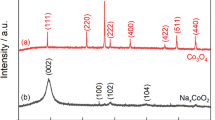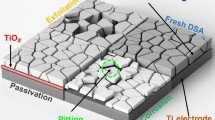Abstract
In the present paper, triethylamine-assisted (CZS) and reference (CZ)-doped CeO2–ZrO2 mixed oxides were prepared by co-precipitation. The prepared samples were characterized by N2 adsorption–desorption, scanning electron microscopy (SEM), transmission electron microscopy (TEM and HRTEM), powder X-ray diffraction (XRD), Raman spectroscopy, and H2 temperature-programmed reduction (TPR). The results showed an improved thermal stability of CZS in textural properties with surface area of 32 and 12 m2 g−1 after aging at 1000 and 1100 °C for 10 h, respectively. Investigation of the sintering behavior disclosed that the sintering of crystallites during high-temperature thermal aging might be related to the packing mode of the grains, since the looser structure of CZS compared to that of CZ hindered the grain growth at high-temperature calcination. The results of XRD and Raman revealed identical structural properties for both materials which suggested a cubic phase in fresh samples and a mixture of cubic and tetragonal phases after thermal aging at severe high temperatures (1000 and 1100 °C). The TPR results showed reduction peaks with rather low-temperatures, which was 414 °C after thermal aging at 1000 °C and 367, 577 °C at 1100 °C. This suggested a high thermal stability of CZS in reduction property. Consequently, the high thermal stability of the mixed oxide in both textural and reduction properties would contribute to the stability of the catalytic activity of the Pd-only three-way catalyst after high-temperature thermal aging, that is, Pd/CZS-a exhibits conversion temperatures of the pollutants (T50 and T90) 10–20 °C lower than Pd/CZ-a.












Similar content being viewed by others
References
Kašpar J, Fornasiero P, Grazinai M (1999) Use of CeO2-based oxides in the three-way catalysis. Catal Today 50:285–298
Di Monte R, Kašpar J (2005) Nanostructured CeO2–ZrO2 mixed oxides. J Mater Chem 15:633–648
Shinjoh H (2006) Rare earth metals for automotive exhaust catalysts. J. Alloys Compd. 408–412:1061–1064
Ozawa M (1998) Role of cerium-zirconium mixed oxides as catalysts for car pollution: a short review. J. Alloys Compd. 275–277:886–890
Di Monte R, Kašpar J (2004) On the role of oxygen storage in three-way catalysis. Top Catal 28:47–57
Kašpar J, Fornasiero P, Hickey N (2003) Automotive catalytic converters: current status and some perspectives. Catal Today 77:419–449
Di Monte R, Kašpar J (2005) Heterogeneous environmental catalysis-a gentle art: CeO2–ZrO2 mixed oxides as a case history. Catal Today 100:27–35
Di Monte R, Kašpar J, Bradshaw H, Norman C (2008) A rationale for the development of thermally stable nanostructured CeO2–ZrO2-containing mixed oxides. J Rare Earths 26:136–140
Fornasiero P, Balducci G, Di Monte R, Kašpar J, Sergo V, Gubitosa G, Ferrero A, Graziani M (1996) Modification of the redox behaviour of CeO2 induced by structural doping with ZrO2. J Catal 164:173–183
Weng X, Perston B, Wang XZ, Abrahams I, Lin T, Yang S, Evans JRG, Morgan DJ, Carley AF, Bowker M, Knowles JC, Rehman I, Darr JA (2009) Synthesis and characterization of doped nano-sized ceria–zirconia solid solutions. Appl Catal B 90:405–415
Aneggi E, Boaro M, Leitenburg CD, Dolcetti G, Trovarelli A (2006) Insights into the redox properties of ceria-based oxides and their implications in catalysis. J. Alloys Compd. 408–412:1096–1102
Yang X, Yang L, Lin S, Zhou R (2015) Investigation on properties of Pd/CeO2–ZrO2–Pr2O3 catalysts with different Ce/Zr molar ratios and its application for automotive emission control. J Hazard Mater 285:182–189
Wang Q, Li G, Zhao B, Zhou R (2011) The effect of rare earth modification on ceria–zirconia solid solution and its application in Pd-only three-way catalyst. J. Mol. Catal. A 339:52–60
Li G, Wang Q, Zhao B, Zhou R (2012) A new insight into the role of transition metals doping with CeO2–ZrO2 and its application in Pd-only three-way catalysts for automotive emission control. Fuel 92:360–368
Lin S, Yang L, Yang X, Zhou R (2014) Redox behavior of active PdOx species on (Ce, Zr) x O2–Al2O3 mixed oxides and its influence on the three-way catalytic performance. Chem Eng J 247:42–49
Suda A, Yamamura K, Morikawa A, Nagai Y, Sobukawa H, Ukyo Y, Shinjo H (2008) Atmospheric pressure solvothermal synthesis of ceria–zirconia solid solutions and their large oxygen storage capacity. J Mater Sci 43:2258–2262
Deshpande AS, Pinna N, Beato P, Antonietti M, Niederberger M (2004) Synthesis and characterization of stable and crystalline Ce1−x Zr x O2 nanoparticle sols. Chem Mater 16:2599–2604
Huang W, Yang J, Wang C, Zou B, Meng X, Wang Y, Cao X, Wang Z (2012) Effects of Zr/Ce molar ratio and water content on thermal stability and structure of ZrO2–CeO2 mixed oxides prepared via sol-gel process. Mater Res Bull 47:2349–2356
Liu J, Liu B, Fang Y, Zhao Z, Wei Y, Gong XQ, Xu C, Duan A, Jiang G (2014) Preparation, characterization and origin of highly active and thermally stable Pd-Ce0.8Zr0.2O2 catalysts via sol-evaporation induced self-assembly method. Environ Sci Technol 48:12403–12410
Bumajdad A, Zaki MI, Eastoe J, Pasupulety L (2004) Microemulsion-based synthesis of CeO2 powders with high surface area and high-temperature stabilities. Langmuir 20:11223–11233
Si R, Zhang YW, Li SJ, Lin BX, Yan CH (2004) Urea-based hydrothermally derived homogeneous nanostructured Ce1−x Zr x O2 (x = 0–0.8) solid solutions: a strong correlation between oxygen storage capacity and lattice strain. J. Phys. Chem. B 108:12481–12488
Terribile D, Trovarelli A, Llorca J, de Leitenburg C, Dolcetti G (1998) The preparation of high surface area CeO2–ZrO2 mixed oxides by a surfactant-assisted approach. Catal Today 43:79–88
Terribile D, Trovarelli A, Llorca J, de Leitenburg C, Dolcetti G (1998) The synthesis and characterization of mesoporous high-surface area ceria prepared using a hybrid organic/inorganic route. J Catal 178:299–308
Hung IM, Wang HP, Lai WH, Fung KZ, Hon MH (2004) Preparation of mesoporous cerium oxide templated by tri-block copolymer for solid oxide fuel cell. Electrochim Acta 50:745–748
Hosokawa S, Iwamoto S, Inoue M (2008) Synthesis of nanocrystalline rare earth oxides by glycothermal method. Mater Res Bull 43:3140–3148
Shigapov AN, Graham GW, McCabe RW, Plummer HK Jr (2001) The preparation of high-surface area, thermally-stable, metal-oxide catalysts and supports by a cellulose templating approach. Appl Catal A 210:287–300
Weng X, Zhang J, Wu Z, Liu Y, Wang H, Darr JA (2011) Continuous syntheses of highly dispersed composite nanocatalysts via simultaneous co-precipitation in supercritical water. Appl Catal B 103:453–461
Huang L, Chen S, Zhu Y, Gong M, Chen Y (2013) Preparation of Ce0.65Zr0.35O2 by co-precipitation: the role of hydrogen peroxide. J Rare Earths 31:461–469
Zhao B, Wang Q, Li G, Zhou R (2010) Effect of synthesis condition on properties of Ce0.67Zr0.33O2 mixed oxides and its application in Pd-only three-way catalysts. J. Alloys Compd. 508:500–506
Hartmann P, Brezesinski T, Sann J, Lotnyk A, Eufing er JP, Kienle L, Janek J (2013) Defect chemistry of oxide nanomaterials with high surface area: ordered mesoporous thin films of the oxygen storage catalyst CeO2–ZrO2. ACS Nano 7:2999–3013
Wang P, Lv A, Hu J, Xu J, Lu G (2012) The synthesis of SAPO-34 with mixed template and its catalytic performance for methanol to olefins reaction. Microporous Mesoporous Mater 152:178–184
Yang R, Liu J, Li M (2004) Sythesis of mesoporous ceria using a non-surfactant template approach. J. Chin. Rare Earth Soc. 22:739–745
Bumajdad A, Zaki MI, Eastoe J, Pasupulety L (2006) Characterization of nano-cerias synthesized in microemulsions by N2 sorptiometry and electron microscopy. J Colloid Interface Sci 302:501–508
Mamontov E, Egami T, Brezny R, Koranne M, Tyagi S (2000) Lattice defects and oxygen storage capacity of nanocrystalline ceria and ceria–zirconia. J. Phys. Chem. B 104:11110–11116
Mamontov E, Brezny R, Koranne M, Egami T (2003) Nanoscale heterogeneities and oxygen storage capacity of Ce0.5Zr0.5O2. J. Phys. Chem. B 107:13007–13014
Yao MH, Baird RJ, Kunz FW, Hoost TE (1997) An XRD and TEM investigation of the structure of alumina-supported ceria–zirconia. J Catal 166:67–74
Colón G, Valdivieso F, Pijolar M, Baker RT, Calvino JJ, Bernal S (1999) Textural and phase stability of Ce x Zr1−x O2 mixed oxides under high temperature oxidising conditions. Catal Today 50:271–284
Kašpar J, Fornasiero P, Balducci G, Di Monte R, Hickey N, Sergo V (2003) Effect of ZrO2 content on textural and structural properties of CeO2–ZrO2 solid solutions made by citrate complexation route. Inorg Chim Acta 349:217–226
Kašpar J, Fornasiero P (2003) Nanostructured materials for advanced automotive de-pollution catalysts. J Solid State Chem 171:19–29
Sun Y, Sermon PA (1996) Surface reactivity and bulk properties of ZrO2 Part 2. Importance of homogeneity in the stabilisation of high surface area CeO2–ZrO2 aerogels. J Mater Chem 6:1025–1029
Bozo C, Gaillard F, Guilhaume N (2001) Characterisation of ceria–zirconia solid solutions after hydrothermal ageing. Appl Catal A 220:69–77
Wang R, Crozier PA, Sharma R, Adams JB (2006) Nanoscale heterogeneity in ceria zirconia with low-temperature redox properties. J. Phys. Chem. B 110:18278–18285
Damyanova S, Pawelec B, Arishtirova K, Huerta MVM, Fierro JLG (2008) Study of the surface and redox properties of ceria–zirconia oxides. Appl Catal A 337:86–96
Kim DJ, Jung HJ (1993) Raman spectroscopy of tetragonal zirconia solid solutions. J Am Ceram Soc 76:2106–2108
Yashima M, Arashi H, Kakihana M, Yoshimura M (1994) Raman scattering study of cubic-tetragonal phase transition in Zr1−x Ce x O2 solid solution. J Am Ceram Soc 77:1067–1071
Lan L, Chen S, Cao Y, Zhao M, Gong M, Chen Y (2015) Preparation of ceria–zirconia by modified coprecipitation method and its supported Pd-only three-way catalyst. J Colloid Interface Sci 450:404–416
Boaro M, Vicario M, de Leitenburg C, Dolcetti G, Trovarelli A (2003) The use of temperature-programmed and dynamic/transient methods in catalysis: characterization of ceria–based, model three-way catalysts. Catal Today 77:407–417
Fornasiero P, Di Monte R, Rao GR, Kašpar J, Meriani S, Trovarelli A, Graziani M (1995) Rh-loaded CeO2–ZrO2 solid solutions as highly efficient oxygen exchangers: dependence of the reduction behavior and the oxygen storage capacity on the structural properties. J Catal 151:168–177
Fally F, Perrichon V, Vidal H, Kašpar J, Blanco G, Pintado JM, Bernal S, Colond G, Daturi M, Lavalley JC (2000) Modification of the oxygen storage capacity of CeO2–ZrO2 mixed oxides after redox cycling aging. Catal Today 59:373–386
Vidal H, Kašpar J, Pijolat M, Colonb G, Bernal S, Cordón A, Perrichon V, Fally F (2000) Redox behavior of CeO2–ZrO2 mixed oxides I. Influence of redox treatments on high surface area catalysts. Appl Catal B 27:49–63
Vidmar P, Fornasiero P, Kašpar J, Gubitosa G, Graziani M (1997) Effects of trivalent dopants on the redox properties of Ce0.6Zr0.4O2 mixed oxide. J Catal 171:160–168
Kašpar J, Di Monte R, Fornasiero P, Graziani M, Bradshaw H, Norman C (2001) Dependency of the oxygen storage capacity in zirconia-ceria solid solutions upon textural properties. Top Catal 16(17):83–87
Fornasiero P, Fonda E, Di Monte R, Vlaic G, Kašpar J, Graziani M (1999) Relationships between structural/textural properties and redox behavior in Ce0.6Zr0.4O2 mixed oxides. J Catal 187:177–185
González-Velasco JR, Gutiérrez-Ortiz MA, Marc JL, Botas JA, González-Marcos MP, Blanchard G (1999) Contribution of cerium/zirconium mixed oxides to the activity of a new generation of TWC. Appl Catal B 22:167–178
Acknowledgements
We gratefully acknowledge the National Natural Science Foundation of China (Grant: 21173153) and Sichuan Province science and technology support program (2014SZ0143) for their generous financial supports to our research.
Author information
Authors and Affiliations
Corresponding author
Ethics declarations
Conflict of interest
The authors declare that they have no conflict of interest.
Rights and permissions
About this article
Cite this article
Zhou, Y., Lan, L., Gong, M. et al. Modification of the thermal stability of doped CeO2–ZrO2 mixed oxides with the addition of triethylamine and its application as a Pd-only three-way catalyst. J Mater Sci 51, 4283–4295 (2016). https://doi.org/10.1007/s10853-016-9733-x
Received:
Accepted:
Published:
Issue Date:
DOI: https://doi.org/10.1007/s10853-016-9733-x




